ガルバノ-ガルバノスキャナーヘッドおよびコントローラー
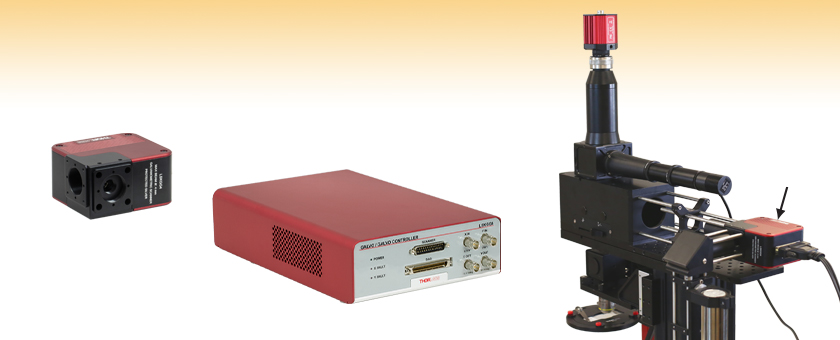
- Large-Area XY Scanning With User-Defined Scan Shapes
- ±7.5° Mechanical Scan Range (±15° Optical Scan Range)
- Pre-Aligned, Wired, and Calibrated for Plug-And-Play Use
- SM-Thread and Cage System Compatible
LSKGG4
4 mm Galvo-Galvo Scanner
Controller
Scan Head
Application Idea
Galvo-Galvo Scanner Incorporated into a Cerna® DIY Microscope System
Galvo-Galvo Scanner

Please Wait
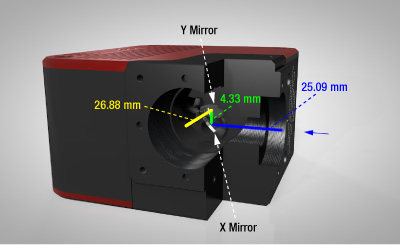
Click for Details
ガルバノ-ガルバノスキャナーヘッドの内部詳細図
スキャナーヘッドと組み合わせて使用する走査レンズの焦点位置は、XとYのミラーの中間点に合わせてください。ミラー間の距離は緑色の線で示されています。そこまでの距離は、入力ポート側に設置する時は表面から27.255 mm、出力ポート側に設置する時は表面から29.045 mmとなります。入力ポートにはSM05内ネジ、SM1内ネジ、および30 mmケージシステム取付け用の4つのØ6 mm内孔があり、出力ポートにはSM1内ネジおよび30 mmケージシステム取付け用の4つの#4-40タップ穴があります。
特長
- Ø4 mm以下のビームに対して、光学走査範囲:±15.0°(機械的走査範囲:±7.5°)
- お手持ちのDC、正弦波または鋸波信号で作動可能
- 位置制御および読み出し用のBNCコネクタ
- National Instruments社のカードおよびブレークアウトボックスに対応
- 可視および近赤外域において反射率の高い保護膜付き銀コーティング
- スキャナーヘッドはSMネジ付きで、30 mmケージシステムおよびポストに取付け可能
当社のガルバノ-ガルバノスキャナLSKGG4/Mには2枚のガルバノ走査ミラーが付いており、入射ビームをX-Y方向に偏向させます。多光子顕微鏡Bergamo® IIIシリーズならびにCerna®がベースの共焦点システムに使用されているガルバノ-ガルバノスキャナと同一製品です。各ミラーの機械的走査範囲は±7.5°で、これは±15.0°の光学走査範囲に対応します。この広い走査範囲により、当社のレーザ走査型顕微鏡用走査レンズSL50xxの回折限界の全視野(FN20)を観察することができます。
コントローラ本体にNational Instruments(NI)社の68ピンコネクタが付いているため、NI社のカードまたはブレークアウトボックス(いずれも付属しません)を使用してスキャナを直接制御したりモニタしたりできます。DC、正弦波、または鋸波の駆動信号を2つのBNCコネクタから供給しても、ビームをステアリングすることができます。その他の2つのBNCコネクタからは、ミラー位置(X、Y)のモニタ信号が出力されます。このスキャナはVidrio社のソフトウェアScanImageにも対応しています。
各走査ミラーは、可視および近赤外域において高い反射率を有する保護膜付き銀コーティングが施されています。詳細については、「仕様」タブをご参照ください。金属製のコーティングであるため、ミラーの機械的走査の全範囲±7.5°に渡り、その性能の変化は大変小さく抑えられています。
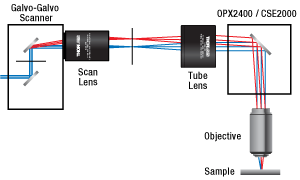
Click for Details
LSKGG4/MはDIYレーザ走査顕微鏡セットアップにも組み込みが可能です。
取付け
スキャナーヘッドの入射面にはSM05内ネジ、SM1内ネジ、ならびに30 mmケージシステム取付け用に4つのØ6 mm内孔が付いています。出射面には、SM1内ネジと、30 mmケージシステム取付け用に4つの#4-40タップ穴が付いています。
走査レンズは、入射瞳が2つのガルバノミラーの中心に来るように設置してください。そこまでの距離は、入力ポート側に設置する時は表面から27.255 mm、出力ポート側に設置する時は表面から29.045 mmとなります。 走査レンズCLS-SLの場合は、ケージシステムサイズ変換アダプタLCP02/Mを用いて30 mmケージシステムを60 mmケージシステムに変換すれば、ケージプレートLCP8S を使用して正しい位置に配置することができます。SM30内ネジ&SM1外ネジ付きアダプタSM1A70も用いることで、走査レンズSL50-CLS2、SL50-2P2、またはSL50-3Pをスキャナの出射ポートから正しい距離に配置することができます。
スキャナーヘッドの重さは0.56 kgで、Ø12 mm~Ø12.7 mm(Ø1/2インチ)ポストまたはØ25 mm~Ø25.4 mm(Ø1インチ)ポストに直接取り付けられます。底部にはM6タップ穴が4つ付いています。
| LSKGG4(/M) Specifications | ||
|---|---|---|
| Internal Galvanometers | ||
| Item #s | QG4X-AG and QG4Y-AG | |
| Mirrors | ||
| Mechanical Scan Range | ±7.5° | |
| Optical Scan Range | ±15.0° | |
| Optical Scan Angle vs. Frequencya | (Click for Graph) Raw Data | |
| Beam Diameter | 4 mm (Max) | |
| Coating | Protected Silver | |
| Reflectance (Average)b | > 92% (450 - 500 nm) > 94.5% (500 - 2000 nm) > 98% (2 - 10.6 µm) | |
| X Mirror Clear Aperturec | Ellipse 6.22 mm Major Axis 4.00 mm Minor Axis | |
| Y Mirror Clear Aperturec | Ellipse 5.82 mm Major Axis 5.22 mm Minor Axis | |
| Front Surface Flatness | < λ/4 (at 633 nm) | |
| Front Surface Quality | 40-20 Scratch-Dig | |
| Substrate | Fused Silica | |
| Position Sensor | ||
| Repeatability | 20 µradd | |
| Small Angle Step Responsee | 200 μs (Typical) | |
| Maximum Step Anglef | 0.65° | |
| Time Delay Between Input and Output Signal | 110 μs | |
| Linearity | 99.9% | |
| Scale Drift | 30 ppm/°C (Max) | |
| Zero Drift | 20 μrad/°C (Max) | |
| RMS Current (Max) | 2.0 A | |
| Peak Current | 6.0 A | |
| Input / Output | ||
| BNC Input | Voltage | -10 V to 10 V |
| Impedance | 10 kΩ | |
| Scale Factor | 1.33 V per Mechanical Degree | |
| BNC Output | Voltage | 0.5 V/deg. or ±3.75 V |
| Impedance | 1 kΩ | |
| Scale Factor | 0.5 V per Mechanical Degree | |
| Controller Voltage Input | 90 - 264 VAC, 50 - 60 Hz | |
| Power Consumption | 120 VA (Max) | |
| Physical | ||
| Scan Head Dimensions | 100.2 mm x 84.5 mm x 50.8 mm (3.95" x 3.33" x 2.00") | |
| Controller Dimensions | 316.7 mm x 199.8 mm x 79.2 mm (12.47" x 7.87" x 3.12") | |
| SM Threading | Internal SM05 (0.535"-40) Internal SM1 (1.035"-40) | |
| Cage Compatibility | 30 mm Cage (4-40 Tap, 4 Places; Ø6 mm Bore, 4 Places) | |
| Post Mounting | 1/4"-20 (M6) Tap, 4 Places | |
| Operating Temperature Range | 0 to 40 °C | |
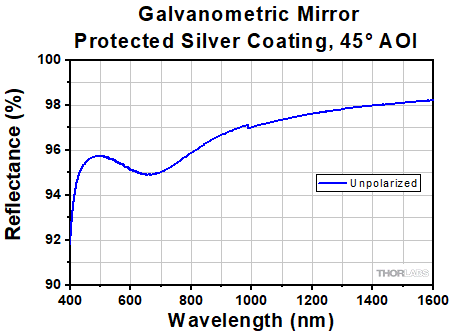
Click to Enlarge
1枚のガルバノミラーの入射角45°に対する反射率特性(典型値)
反射率はロットごとに異なる場合がございますのでご注意ください。左の表に示しているのは、推奨波長範囲における平均反射率の最小値を含んだ値です。

Click for Details
ガルバノ-ガルバノスキャナーヘッドの内部詳細図
スキャナーヘッドと組み合わせて使用する走査レンズの焦点位置は、XとYのミラーの中間点に合わせてください。ミラー間の距離は緑色の線で示されています。そこまでの距離は、入力ポート側に設置する時は表面から27.255 mm、出力ポート側に設置する時は表面から29.045 mmとなります。入力ポートにはSM05内ネジ、SM1内ネジ、および30 mmケージシステム取付け用の4つのØ6 mm内孔があり、出力ポートにはSM1内ネジおよび30 mmケージシステム取付け用の4つの#4-40タップ穴があります。
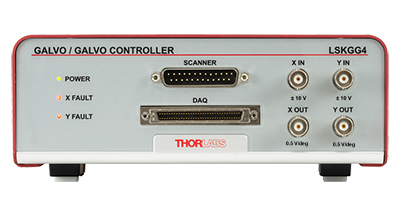
Click to Enlarge
コントローラ前面にはスキャナーヘッド接続ケーブルDB25用のコネクタ、ならびに位置制御および読出し用のBNCコネクタとNI社製68ピンコネクタが付いています。
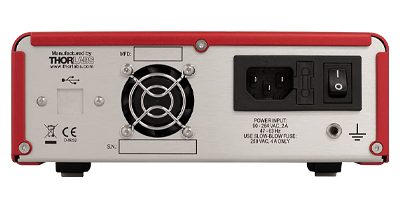
Click to Enlarge
コントローラ背面にはスキャナーヘッドのガルバノスキャナを制御するためのUSBポートのほか、ヒューズホルダ、電源スイッチ、接地用ピンコネクタをが付いています。
X INならびにY IN
BNCメス型
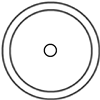
| X IN and Y IN | |
|---|---|
| Input Signal Types | DC, Sine, Sawtooth, or Triangle Wave |
| Input Voltage Range | ±10 V |
| Input Impedance | 10 kΩ |
| Input Scale Factor | 1.33 V per Mechanical Degree |
X OUTならびにY OUT
BNCメス型

| X OUT and Y OUT | |
|---|---|
| Output Voltage Range | ±3.75 V |
| Output Impedance | 2 kΩ |
| Output Scale Factor | 0.5 V per Mechanical Degree |
DAQ
NI社製68ピンコネクタ*

* 表中のインピーダンスは、このコネクタにNI社製以外のDAQカードやファンクションジェネレータを接続する場合のために記載しています。NI社製のケーブルで直接NI社製カードに接続する場合には考慮する必要はありません。
| DAQ | ||
|---|---|---|
| Pin | Name | Description |
| 21 | Y Position In | ±10 V Input 200 kΩ Impedance |
| 22 | X Position In | ±10 V Input 200 kΩ Impedance |
| 26 | X Velocity | Output Voltage Proportional to Scanner Velocity 2 kΩ Impedance |
| 28 | Y Velocity | Output Voltage Proportional to Scanner Velocity 2 kΩ Impedance |
| 30 | X Position Out | ±3.75 V Output 2 kΩ Impedance |
| 38 | Y Fault | Output Pulled from 12 V to 0 V When Fault Detector Trips 4.75 kΩ Impedance |
| 46 | X Fault | Output Pulled from 12 V to 0 V When Fault Detector Trips 4.75 kΩ Impedance |
| 54 | Ground | Ground Return for User Inputs |
| 57 | X Current | Output Voltage Proportional to Motor Current 2 kΩ Impedance |
| 60 | Y Current | Output Voltage Proportional to Motor Current 2 kΩ Impedance |
| 65 | Y Position Out | ±3.75 V Output 2 kΩ Impedance |
LSKGG4(/M)発送リスト
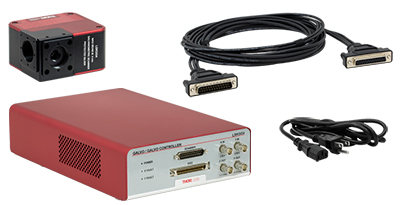
Click to Enlarge
LSKGG4(/M)
ガルバノ-ガルバノスキャナには以下の製品が含まれます。
- スキャナーヘッド
- コントローラ
- スキャナーヘッド用制御ケーブルDB-25
- AC電源コード(日本国内用)
ガルバノ-ガルバノスキャナは様々な入力信号を用いてステアリングできるため、BNCケーブルもNI社製68ピンケーブルも付属しません。
| Posted Comments: | |
Shi Guo
(posted 2024-04-17 13:31:50.05) I need to build a confocal laser scanning setup and I need some technical assistance about Telecentric Scanning Lenses jpolaris
(posted 2024-04-22 07:14:05.0) Thank you for contacting Thorlabs. Telecentric scan lenses are designed to create a uniform spot size in the image plane at every scan position, which allows a high-quality image of the sample to be formed. There is some discussion about telecentric scan lenses at the following link. I have reached out to you directly to discuss in more detail your application requirements and goals. https://www.thorlabs.com/newgrouppage9.cfm?objectgroup_id=2910&tabname=Application_Info user
(posted 2023-10-09 16:34:41.62) Even when I turn on the power, power, X FAULT, and Y FAULT just flash and it doesn't work.
Please tell me the solution Raj M
(posted 2022-09-06 12:11:36.46) We are looking for a laser micromachining head/galvanometer scan head to attach it to a 5-axis CNC for a 3D part micromachining. Do you have any product that matches our description? cdolbashian
(posted 2022-09-16 09:43:26.0) Thank you for reaching out to us with this inquiry, and thinking of us for your application. I have reached out to you directly to discuss this request. user
(posted 2021-07-29 21:15:42.233) Dear Thorlabs staff,
I have LSKGG4 in lab, and wanted to control Galvo scan using Matlab. Could you please tell me how to do that? Do you have any Matlab code to be provided to us?
Thank you
Dayan Li YLohia
(posted 2021-07-29 01:58:07.0) Hello Dayan, thank you for contacting Thorlabs. The LSKGG4 does not have any direct software control capabilities. We do, however, provide an NI 68-pin connector on the controller that can be interfaced with a National Instruments Data Acquisition Card for programmatic control. Please contact National Instruments directly to find the best DAQ card for your needs. Georgi Yankov
(posted 2021-03-12 08:19:16.733) Hello,
Iskam yes nourished tozi laser skene for coy dalzhini on work. And can you work from dlzhin to vlnata 6.45 micronmeters YLohia
(posted 2021-03-12 03:38:27.0) Hello, thank you for contacting Thorlabs. Unfortunately, we don't have anyone at Thorlabs that speaks Bulgarian and Google Translate did not do a good job of translation-- would you be able to email your request in English? We will discuss this directly. Benjamin Judkewitz
(posted 2019-11-07 04:17:25.677) The idea is great, but the unfrotaunte choice of a small mirror diameter (4 mm) makes this useless for our (and many of our colleagues) applications. Are there any plans to offer 5 mm or 6 mm versions? This would be very interesting to us. Best, Benjamin YLohia
(posted 2019-11-07 11:01:45.0) Hello Benjamin, thank you for your feedback. We currently offer 5mm clear aperture Galvo-Resonant Scanners here : https://www.thorlabs.com/newgrouppage9.cfm?objectgroup_id=11579. I have posted your request on our internal product engineering forum for further consideration. user
(posted 2019-06-05 10:27:13.433) Hi there
Could you incorporate larger mirrors in this scan head, e.g. to accommodate a 8 mm beam waist? Thank you YLohia
(posted 2019-06-05 03:58:11.0) Hello, thank you for contacting Thorlabs. We will reach out to you directly to discuss the possibility of offering this customization. andriy.chmyrov
(posted 2019-01-25 16:19:29.63) Dear Tech Support,
could you, please, highlight the differences of LSKGG4/M compare to 'an ordinary' GVS002 XY-galvo set? One obvious thing is an easy integration into a cage system. What are the other key benefits which are included in 5 times higher price?
Thanks for your feedback! llamb
(posted 2019-01-29 08:46:50.0) Thank you for contacting Thorlabs. For a few key advantages, the LSKGG4/M offers a faster max full angle scan rate (500 Hz vs 250 Hz for a sine wave input), a faster small angle step response (130 µs vs 300 µs), better repeatability (within 8 µrad instead of 15 µrad), and overall a more user-friendly design ready for plug-and-play use. It has a National Instruments 68-pin connector for direct control from an NI card, and it is also compatible with Vidrio's ScanImage software. We will reach out to you directly to see if this product is best suited for your application. user
(posted 2018-06-21 03:51:28.26) Hello. I want to know whether the resonant mirror's scanning velocity is variable or not. YLohia
(posted 2018-06-26 10:11:44.0) The scan velocity is variable from 0-500 Hz. amelie2777
(posted 2017-10-30 09:13:46.637) Is the LSK-GG galvo mirror system operated at a closed-loop condition?
For a small angle (±0.2°), what is the (small angle) step response and what is the maximum scan frequency or (small angle) bandwidth?
What is the angular resolution? Thanks. nbayconich
(posted 2017-11-09 12:08:14.0) The LSK-GG allows customer access to all input and output signals to the galvos. It is completely up to the customer how they want to drive the mirrors. The kit is merely the galvos with controllers. Any interfacing with a DAQ card/system will have to be done by the customer. For closed-loop operation, the customer would have to write their own script. ThorImage, for example, drives these in Open Loop mode, that is, it doesn’t look at the encoder signal from the mirrors. It just feeds a sinusoidal wave to the mirrors so that they scan the field of view.
https://www.thorlabs.com/newgrouppage9.cfm?objectgroup_id=10647
On the Specs tab we have the Small Angle Step Response to be 130us (Typical). The response corresponds to a 0.1 deg movement from 1% to 99% of its final position.
The Specs tab also mentions a bandwidth of 500Hz for full swing (-10V to 10V or -7.5 deg to 7.5 deg mechanical). h.wu
(posted 2017-05-21 12:47:08.213) Dear Thorlabs, could you tell me the damage threshold for LSK-GG? Is the optical scan range of LSK-GG dependent upon the input beam size?
I also would like to know the diameter of the view field (field of view) for LSK-GG with SL50-CLS2 scan lens at the intermediate image plane.
I will use the NI 68-Pin connector of the controller for position control and readout so how could I put 200 kΩ resistors in pin 21 and 22 positions (between NI 68-Pin connector of the controller and NI SHC68-68-EPM cable)? Or 200 kΩ resistors were pre-installed inside the NI 68-Pin connector of the controller? The same question for 2 kΩ in pin 26, 28, 30, 57, 60 and 65.
Why is the price of LSK-GG so expensive compared to that of GVS002/M? Could you provide special offers or bundle deals for such complete system package (LSK-GG + SL50-CLS2 + TL200-CLS2)?
Thank you. nbayconich
(posted 2017-06-07 04:05:09.0) Thank you for contacting Thorlabs. At the moment we do not have a damage threshold specification for the LSK-GG but they are intended to be used with ti sapphire lasers up to 1 watt CW power that fills the clear aperture.
The SL50-CLS2 has a smaller optical scan angle we also have the CLS-SL if you need a larger field of view.
The field of view will be close to the size of the image at the focal plane, but if you want diffraction-limited performance, you must limit the input to be within the below field of view:
23.8 x 23.8 mm2
The scanner is meant for a Ø4mm beam or smaller but the scan range is not dependent on the input beam size.
SL50 scan lenses have a smaller FOV. We have the CLS-SL if you need a bigger FOV. The field of view will close to the size of the image at the focal plane, but if you need diffraction-limited performance, you should limit the input to be within the field of view: 23.8 x 23.8 mm2
The price of the LSK-GG compared to the GVS galvo units is significantly higher because the GVS series are more intended for OEM applications and also do not support a simple plug and play configuration like the LSK-GG.
A Techsupport representative will contact you directly with more information. |
 Products Home
Products Home

















 ガルバノ-ガルバノスキャナ、広域走査用
ガルバノ-ガルバノスキャナ、広域走査用